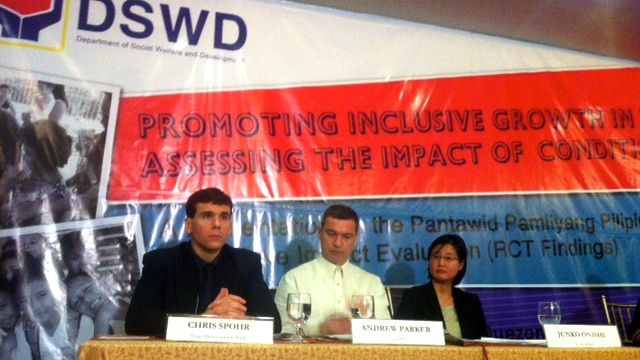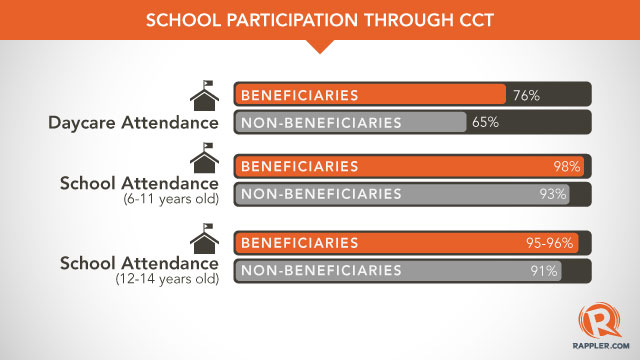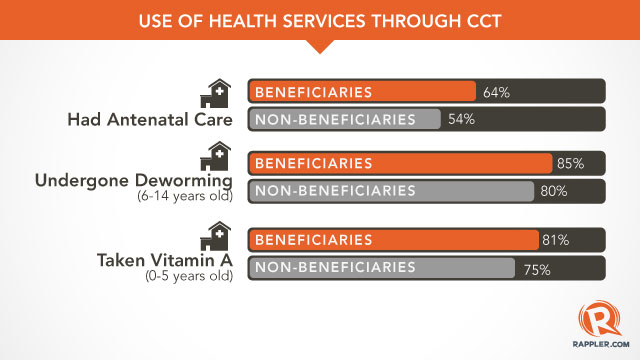SUMMARY
This is AI generated summarization, which may have errors. For context, always refer to the full article.

MANILA, Philippines – The Department of Social Welfare and Development (DSWD) found respite from blows it has been getting from left and right, including a Commission on Audit (COA) report that questioned the capacity of the agency to implement the government’s flagship poverty alleviation program.
On Friday, March 1, the World Bank (WB) reported that the Conditional Cash Transfer (CCT) or Pantawid Pamilyang Pilipino Program is “on track to meet the goals of keeping children healthy and in school.”
Emboldened by the positive evaluation, DSWD shifted into fighting mode. Undersecretary Rodora Barbaran, Pantawid Pamilya national manager, reiterated that COA’s claim that almost 10% of CCT’s beneficiaries “are not really poor” is based on a sampling method that is “not rigorous enough.”
The World Bank defended the embattled DSWD, saying that “there was nothing glaring that came out (in the COA report) that was problematic.”
“What we’ve seen from the COA report and what we’ve seen from the DSWD explanation, their (rebuttal) to the COA report is what we’re more than satisfied with,” Dr Nazmul Chaudhury, World Bank country sector coordinator for human development, told Rappler.
Chaudhury co-authored a recently completed assessment of the controversial CCT program which provides cash grants to more than 3 million poor families benefitting about 600 million children. Families enrolled in the program get a monthly cash grant of P500 to cover healthcare costs while each child below 14 years old gets P300 for education.
Compliant beneficiaries
The World Bank report, the first of a 3-wave evaluation being conducted on CCT in coordination with the DSWD, AusAID, and the Asian Development Bank (ADB), favorably assessed the implementation of the program.
The study revealed high compliance of beneficiaries with requirements set by the program, including keeping children in school and availing of medical care.
“Poor households under the program spend 38% more in education per capita and 34% more on medical expenses per capita than their non-Pantawid counterparts. This trend indicates a shift in the spending pattern among CCT beneficiaries towards greater investments in health and education of their children,” Chaudhury said.

The report highlighted the following findings as far as the requirement on education is concerned:
• 76% of preschoolers in CCT beneficiary barangays (villages) are enrolled in daycare, compared to 65% in non-CCT barangays
• 98% of children aged 6-11 years old in CCT barangays are enrolled in school, as against 93% in non-CCT barangays
• 95-96% of children aged 12-14 years old in CCT barangays have higher school attendance compared to 91% in non-CCT barangays
But the report said that CCT failed to keep older children in school, noting that enrollment of 12-14-year-old children who are covered under the program did not improve.
Reduction in severe stunting
The program is also achieving its objective of keeping children healthier as particularly reflected in the decrease in the severe stunting among poor children in the age bracket 6-36 months in CCT beneficiary barangays, the report emphasized.
“This reduction in severe stunting indicates that CCT is enabling families to better care for their children. More parents in Pantawid barangays are feeding their children with high-protein food, including eggs and fish, leading to improved nutritional status,” according to WB social protection specialist Junko Onishi.

The report cited other key improvements as far as compliance with health requirements is concerned:
• 64% of pregnant mothers in CCT beneficiary barangays had antenatal care as against 54% in non-CCT barangays
• 85% of 6-14-year-old children in CCT barangays underwent deworming as against 80% in non-CCT barangays
• 81% of 0-5-year-old children in CCT barangays took Vitamin A supplements as against 75% in non-CCT barangays
Hope more than numbers
The World Bank said that the report, which is based on a survey of 1,418 poor households, aimed to present empirical evidence on the impact of the CCT program.
But according to Chaudhury, what is more important is that the program is felt on the ground.
“What makes me happy is not really the numbers. It’s really when you go down to the field level and you’re talking to some of these beneficiaries, and you see for the first time that they’re going into a health clinic. For the first time they think they can send their child to school, and they can be linked up to the social services. It’s really the hope.”
Satisfied with the performance of the government, the World Bank said it is committed to continue helping in financing the large-scale poverty alleviation program for as long as its assistance is sought.
The Washington-based lender extended an additional US$100-million loan in December 2012 to help finance the P44.2 billion CCT program. It has poured about half a billion dollars into the Aquino government’s social protection programs, according to Chaudhury.
Rolled out in 2008, the CCT rapidly evolved into the government’s main social protection effort that is slated to end by 2015. – Rappler.com
Add a comment
How does this make you feel?
There are no comments yet. Add your comment to start the conversation.